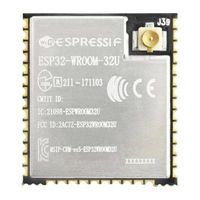Espressif Systems ESP32 Series Manuals
Manuals and User Guides for Espressif Systems ESP32 Series. We have 9 Espressif Systems ESP32 Series manuals available for free PDF download: Technical Reference Manual, Faq, Instruction Set, Hardware Design Manuallines, Manual, Design Manuallines
Espressif Systems ESP32 Series Technical Reference Manual (735 pages)
Brand: Espressif Systems
|
Category: Single board computers
|
Size: 9 MB
Table of Contents
Advertisement
Espressif Systems ESP32 Series Faq (191 pages)
Brand: Espressif Systems
|
Category: Motherboard
|
Size: 0 MB
Table of Contents
Espressif Systems ESP32 Series Instruction Set (103 pages)
AT Instruction Set and Examples
Brand: Espressif Systems
|
Category: Single board computers
|
Size: 4 MB
Table of Contents
Advertisement
Espressif Systems ESP32 Series Technical Reference Manual (126 pages)
Brand: Espressif Systems
|
Category: Computer Hardware
|
Size: 1 MB
Table of Contents
Espressif Systems ESP32 Series Hardware Design Manuallines (44 pages)
Brand: Espressif Systems
|
Category: Computer Hardware
|
Size: 4 MB
Table of Contents
Espressif Systems ESP32 Series Hardware Design Manuallines (32 pages)
Brand: Espressif Systems
|
Category: Microcontrollers
|
Size: 0 MB
Table of Contents
Espressif Systems ESP32 Series Manual (29 pages)
Brand: Espressif Systems
|
Category: Microcontrollers
|
Size: 11 MB
Table of Contents
Espressif Systems ESP32 Series Hardware Design Manuallines (30 pages)
Brand: Espressif Systems
|
Category: Microcontrollers
|
Size: 6 MB
Table of Contents
Espressif Systems ESP32 Series Design Manuallines (22 pages)
Brand: Espressif Systems
|
Category: Recording Equipment
|
Size: 4 MB
Table of Contents
Advertisement
Related Products
- Espressif Systems ESP32-D2WD
- Espressif Systems ESP32-S0WD
- Espressif Systems ESP32-D0WDQ6
- Espressif Systems ESP32-D0WD
- Espressif Systems ESP32-C3 Series
- Espressif Systems ESP32-C3-WROOM-1
- Espressif Systems ESP32-C3-WROOM-02
- Espressif Systems ESP32-C3FH4
- Espressif Systems ESP32-C3-MINI-1-N4
- Espressif Systems ESP32-C6 Series








